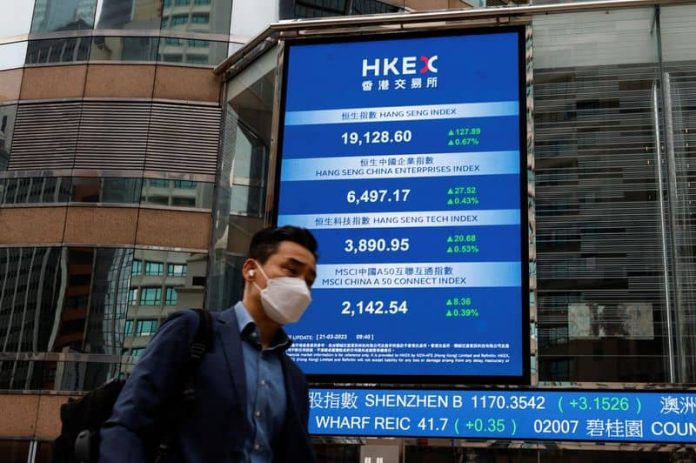LONDON (Reuters) -Global shares rose on Thursday, while the dollar held near two-month lows after U.S. inflation data suggested the Federal Reserve may soon be finished raising interest rates, which in turn kept gold above $2,000 an ounce.
The euro hit a 2-1/2 month high at $1.103. Investors are positive on Europe, where blue-chip stocks hit a two-decade peak on Wednesday, and reckon Europe’s central bankers will need to be more hawkish longer than their U.S. counterparts to rein in rising prices.
The broader STOXX 600 index rose 0.3%, buoyed by shares in LVMH hitting a record high after the luxury retailer reported booming sales in China in the first quarter of 2023. London’s FTSE 100 lagged the rest of the region after data showed the British economy stagnated in February.
After long weekends in much of the world, this week is fairly action-packed in terms of economic data. Still to go are U.S. producer prices and retail sales, both of which could help set expectations for what the Fed might do at its May meeting.
“If as expected or lower, this may be enough for markets to start to discount a smaller probability of a Fed rate hike at its May meeting, but it may also require retail sales to fall as expected tomorrow,” ADM Investor Services chief global economist Marc Ostwald said.
Tuesday’s read on U.S. consumer inflation showed prices barely rose in March. The annual 5% headline rise for U.S. inflation was the smallest since May 2021 and down from 9.1% last June.
Though with core CPI sticky at an annual 5.6% and minutes from last month’s Fed meeting showing participants cautious about credit tightening in the wake of banking sector wobbles in March, markets are nervous.
“The market view is a bit split on whether it’ll be a ‘hawkish hold’ or a ‘dovish hike’,” Aninda Mitra, head of Asia macro and investment strategy at BNY Mellon (NYSE:BK) Investment Management, referring to next month’s Fed meeting.
“Whichever way you look at it, it’s probably not going to be a series of hikes, it’s probably going to be one more to hit the peak before you start to reassess, you either reassess now, or you hike and then reassess,” he said.
The dollar index was down 0.2%, near its lowest in two months, while U.S. stock futures rose 0.1-0.2%, suggesting a modest rally at the open.
However, given the Fed’s concern about banks, much of the week’s focus will fall on earnings from Citi, Wells Fargo (NYSE:WFC) and JP Morgan Chase (NYSE:JPM) due on Friday.
“It is an ‘if’ monetary policy world, that is, wait and see about banking and financial conditions,” said Sam Rines, managing director at research firm CORBŪ in Texas. “Banking sector issues are explicitly part of the reaction function now.”
Two-year Treasury yields were steady at 3.962% after dropping more than 8 basis points on Wednesday. More tellingly, as investors place more of a chance on the European Central Bank raising rates for longer, the gap between 10-year U.S. Treasury yields and 10-year Bund yields reached its narrowest in two years, reflecting the steeper rise in German yields.
NO BLOW-UPS, FOR NOW
Goldman Sachs (NYSE:GS)’ chief economist Jan Hatzius sounded upbeat, noting risks of an outright banking crisis have declined sharply since no further banks have blown up since the weekend of the collapse of Silicon Valley Bank a month ago.
Still, there is pressure and warning signs, particularly for regional lenders, with Rines pointing to the Bank of South Carolina which noted “precipitous increases” in deposit costs and thin margins in its first-quarter earnings this week.
Elsewhere, gold rose 0.64% to $2,027 an ounce, near its highest for a year. A weaker dollar and the prospect of a decline in rates means gold, which does not bear any kind of interest of its own, can compete more effectively for investor money, especially if inflation is proving persistent, given its reputation as a hedge against rising price pressures.
The Aussie dollar rose 0.6% on the back of surprise surges in both Chinese exports, which rose 14.8% compared with last March, and domestic Australian jobs.
China’s major stock indexes were slightly in the red, with analysts saying an unexpected rise in March exports was unlikely to be sustained given softening global demand.
Chinese tech stocks slid after the Financial Times reported SoftBank was selling down its Alibaba (NYSE:BABA) stake, on the heels of Netherlands investor Prosus (OTC:PROSF) flagging some selling of its Tencent stake on Wednesday. Alibaba shares fell by as much as 5% at one stage, but later pared losses to close 2% lower. In U.S. premarket trading they were up about 1.8%.



















